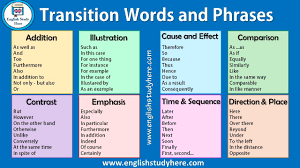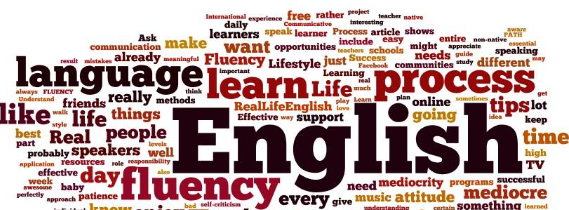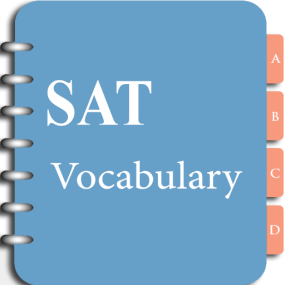Từ nối là các cụm từ hoặc từ kết nối các ý tưởng lại với nhau. Có các loại từ nối chính sau:
1. Từ nối biểu thị sự tương đồng: similarly, again, also, correspondingly, equally, likewise
VD: Lentils are an excellent way to add plant-based protein to one's diet. Similarly, other legumes, like beans and chickpeas, can serve as integral protein sources for vegans and vegetarians.
2. Từ nối biểu thị sự tương phản: but, yet, conversely, though, still, in contrast, although, nevertheless, on the other hand.
VD: People tend to put on weight in middle age. However, gaining weight is not inevitable.
3. Từ nối biểu thị trình tự, thứ tự:
Các từ nối này mang ý nghĩa chỉ sự tương tự, trình tự: previously, then, later, before, first, finally, and subsequently.
VD: The Pulitzer Prize-winning novel A Confederacy of Dunces was published in 1980, seventeen years after it was written. Previously, the novel had been rejected by many different publishers.
 4. Từ nối biểu thị bổ sung thêm ý mới:
4. Từ nối biểu thị bổ sung thêm ý mới:
Các từ nối này dùng để đưa ra thêm ý hoàn toàn mới so với ý trước, tuy vẫn cùng mạch phát triển ý chính của đoạn: additionally, in addition, furthermore, also, too, moreover.
VD: Moles are highly suited to their lifestyle, with short, powerful forelimbs adapted for digging. Furthermore, moles have evolved to require less oxygen, allowing them to avoid suffocation while underground.
5. Từ nối để đưa ra dẫn chứng cho ý trước đó
Các từ nối này dùng khi đưa ra dẫn chứng bổ sung hoặc đưa ra ví dụ: in fact, indeed, for example, for one thing, for instance, to demonstrate, hoặc to illustrate.
VD: It was not expected to last long, and indeed it took less than three weeks
6. Từ nối biểu thị nhân quả:
Các từ nối này mang ý nghĩa nhân quả: since, because, subsequently, thus, hence, as a result, and consequently.
VD: The Hubble Space Telescope has provided astronomical insights for over 30 years, but its eventual breakdown is inevitable.
Therefore, its successor, the James Webb Space Telescope, was launched in late 2021.
Bước 1: Tự tóm tắt lại đoạn văn
Đừng chỉ đọc lướt qua đoạn văn, các em hãy đọc kỹ và cố gắng tóm tắt ý chính bằng ngôn từ của mình. Các em có thể gạch ra một số ý chính từ đoạn văn để dễ dàng kết nối các ý chính.
Bước 2: Xác định mối quan hệ giữa các ý của đoạn văn
Qua bước 1, các em đã hiểu ý chính. Vậy đoạn văn này cần từ nối nào để kết hợp hai ý tưởng từ đoạn văn? Hãy tìm ra mối quan hệ giữa chúng bằng cách tự hỏi: Hai ý tưởng này có liên quan như thế nào? Chúng trái ngược nhau? Ý tưởng này dẫn đến ý tưởng kia? Các em có thể xếp mối quan hệ này vào một trong bốn loại từ nối ở trên.
Bước 3: Chọn từ nối phù hợp với mối quan hệ
Chỉ một trong các đáp án sẽ phù hợp với mối quan hệ mà các em đã xác định. Nếu các em thấy mình bị phân vân giữa hai đáp án, hãy thử điền từng đáp án vào chỗ trống. Từ nối nào sẽ phù hợp hơn trong ngữ cảnh đó?

Quay lại ví dụ ban đầu:
Iraqi artist Nazik Al-Malaika, celebrated as the first Arabic poet to write in free verse, didn’t reject traditional forms entirely; her poem “Elegy for a Woman of No Importance” consists of two ten-line stanzas and a standard number of syllables. Even in this superficially traditional work, ______ Al-Malaika was breaking new ground by memorializing an anonymous woman rather than a famous man.
→ Bước 1: Al-Malaika sometimes used “traditional forms”. Even when she used traditional forms, Al-Malaika was “breaking new ground”.
→ Bước 2: Hai ý trên đối nghịch nhau("traditional" vs. "new").
→ Bước 3: Từ nối thuộc nhóm đối nghịch là
B. though.





Trần Đình Quang (1560 SAT, THPT Chuyên Khoa Học tự nhiên) Trải nghiệm học SAT với TOEFL, con chỉ biết diễn tả bằng 3 từ thôi: Quá tuyệt vời Con chưa từng thấy ai hiểu biết mà vẫn vô cùng quan tâm và biết lắng nghe, chia sẻ như cô Vân Anh. Kể cả sau 3 năm rồi, con vẫn cảm thấy rất an toàn khi luôn có 1 cô giáo nhiệt tình và thông thái như cô ở gần bên. "You are always there, teacher, and I don't really know how much I appreciate your help and guidance".